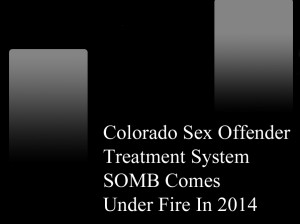




Apr 22
Colorado Sex Offender Treatment System SOMB Comes Under Fire In 2014
 By H. Michael Steinberg Denver Colorado Sex Crimes Criminal Defense Lawyer Email the Author at [email protected]
By H. Michael Steinberg Denver Colorado Sex Crimes Criminal Defense Lawyer Email the Author at [email protected]
Colorado Sex Offender Treatment System SOMB Comes Under Fire In 2014 – This year – 2014 – the Colorado state legislature commissioned a study by Dr. Deirdre D’Orazio, Dr. Anthony Beech and Dr. David Thornton (Central Coast Clinical and Forensic Psychology Services) to scrutinize the Colorado SOMB Sex Offender Management Board standards that have so unfairly impacted so many lives here in Colorado.
The study (the study) was over 168 pages in length and this summary is intended only to focus the reader on the most serious criticisms by the expert writers of the study. This information can prove to be very useful in plea negotiations, sentencing hearing, probation revocations, parole applications and revocations and the like. My summary of the parts of the report I found helpful includes some anecdotes based upon my personal opinion.
Colorado Falls Behind National and International Sex Offender Treatment Research -“No Known Cure” Rejected
Most despised among the approaches Colorado takes to convicted sex offender treatment is the “one size fits all – no known cure” model applied in nearly all case.
While the “no known cure” terminology has been removed in the SOMB’s Standards and Guidelines, the enforcement of the concepts and structure behind this theory – remains in place.
In 2013 a similar commissioned study by the Colorado State Legislature recommended using the more humane and reasonable “Risk, Need and Responsivity Model (RNR).”
The RNR Model is based on three principles:
1) the risk principle asserts that criminal behavior can be reliably predicted and that treatment should focus on the higher risk offenders;
2) the need principle highlights the importance of criminogenic needs in the design and delivery of treatment; and
3) the responsivity principle describes how the treatment should be provided.
Summary:
-
- Risk principle: Match the level of service to the offender’s risk to re-offend.
- Need principle: Assess individual criminogenic needs and target them in treatment.
- Responsivity principle: Maximize the offender’s ability to learn from a rehabilitative intervention by providing cognitive behavioural treatment and tailoring the intervention to the learning style, motivation, abilities and strengths of the offender.
This model – not the subject of this post – will be addressed in future articles and posts on this site.
A Brief Summary Of The Criticisms Of Colorado SOMB Standards And Guidelines System
• Many low risk offender-clients do not need lifetime supervision and treatment.
• Assessment tools such as the STATIC 99 and the SOTIPS can identify these low risk persons. The removal of these offenders means that hundreds of thousands of treatment dollars can be focused on those who truly require this level of supervision.
• Several of the currently used “assessment instruments” are outdated and need to be replaced with new tools that are used nationally and internationally and are more reliable instruments
Suspect tools include: the Sexually Violent Predator Assessment, the Child Contact Assessment and the Low Risk Assessment. Many offender – otherwise low risk – are isolated from their families because of carry over from the one size fits all “no known cure” approach.
• Colorado DOC Parole release criteria have not changed in over a decade and are no longer considered reliable. Research has established that the two methods used by Colorado parole boards “Offense Cycles and Relapse Prevention Plans are outdated.
More specific criticisms include:
• The requirement that the offender is to be held accountable for everything in the police and victims’ reports. Anyone who has any experience in the criminal justice system knows that police reports are filled with one sided exaggerations on the part of the police, witnesses and the alleged victim.
• Notwithstanding the alleged victims participation or contribution to an individual crime – parolees and probationers must have complete empathy for the victims and pass a comprehensive Sexual History Polygraph Examination. Research demonstrates that recidivism (repeating the same crime) is not related to this approach.
Other Criticisms In The Study…
The Use And Abuse Of The SOMB Polygraph
The SOMB polygraph is overused and over relied upon. Sexual History Polygraphs – applied in the context of sex offender treatment modalities – are unreliable. Again – those experienced in the criminal justice system know that “poly’s are only reliable in simple single issue cases such as “did you rob that 7-11.” They have little success in areas such as “did you rape that woman?”
False findings in the context of “multiple issue polygraphs” points to the misuse, abuse, and overuse of the polygraph in Colorado.
Polygraph use is excessive. Polygraphs are used not only compulsively but their use is punitive and rigid. They are not used as the treatment tool originally intended. The polygraph has become the center of the treatment – instead of a useful tool to make treatment successful.
Even inconclusive polygraph results (results can be pass, fail or inconclusive) are interpreted by the decision makers as the same manner as deceptive test results.
Failing A Polygraph
Sex Offender Treatment can be and is sometimes terminated due to a failed polygraph. This occurs even when there have been many years of passing polygraphs. A failed “poly” can lead to a revocation of probation or parole and the re-incarceration of the offender.
Many of the contracted Colorado polygraphers – given the few companies that have these contracts “over fail” offenders because if offenders pass too many polygraphs – the vendor is “blackballed” from the referral list. Quality control of polygraphers is almost non-existent.
Treatment That Never Ends – Repeatedly Going Through The Same Treatment Modalities – Does NOT Work
Sex offender treatment is cycled and recycled with repeated starts and stopped. Many offenders must take the same courses over and over again irrespective of the actual lack of threat they may represent. Taking and retaking the same classes in not working. The literature demonstrates that being supervised too long has the opposite effect than the one sought and ‘is actually a precursor of increased recidivism in those with low risk to reoffend.’
The Failure of the Treatment (CST) Triangle
The Containment Model creates a “triangle” as between the polygraphers, the therapists and the supervising officers (parole and probation). The level of cooperation and professionalism that exists in any working group often fails to reach consensus about appropriate treatment modalities and levels of supervision over the offender.
Disagreements mean that probation and parole officers – (the least trained and educated on the therapeutic environment – HMS) have the last word and there are few avenues for the mediation of these disputes under SOMB Standards and Guidelines.
Therapists who rely on their relationships with probation officers for their referrals are forced to sacrifice their ethical standards of practice and fall in line behind the decisions of the supervising officers – or lose business tadalafil generic.
Therapists Who Do NOT Agree With The PO Risk Losing Lucrative Referrals
Clinical judgments that are inconsistent with those of the supervision officers lead to those therapists being “black-balled” from referrals by parole and probation officers as these supervising officers control treatment referrals.
A Further Rejection Of The Containment Model
The study rejects the “containment model’s” basic premise that all offenders are equally, highly and perpetually dangerous. Unlike other Colorado sentencing laws – this model destroys hope in the offender and his family. It does NOT recognize the kind of “protective factors” that establish a path to success. The focus on external control over the internal change of the offender actually has the opposite result than the one desired.
The SOMB Guidelines Unnecessarily Destroy Families – Contact With Children and Family
The SOMB Standards and Guidelines are harsh and insensitive to the survival of the family. Many convicted sex offenders pose no threat to their children and or their minor siblings. In these cases the offender’s return home is in the best interest of family.
The SOMB Guidelines are absolute as to contact with children under the age of 18. Even offenders who have no history of victimizing a child are prohibited from any contact with minors
including working anywhere where it is possible to have contact with minors. This kind of blind adherence to regimented decision making ignores the person – the individual who is being sentenced.
Unlike all other sentencing guidelines – these are not “guidelines” at all – they are rules – and their application in every case flies in the face of a criminal justice system that treats every individual as a person.
Colorado Sex Offender Treatment System SOMB Comes Under Fire In 2014
You Might Also Enjoy:
- Colorado Sex Offender SOMB Standards Finally Reject No Known Cure Approach
- Colorado Criminal Sex Crimes Law – Denial While On Probation And Implications For Sex Offender Probation Violations And Re-Sentencing
- 2014 – Colorado Increases The Minimum Mandatory Sentences For Certain Sex Crimes
- Fifth Amendment Right NOT To Take Sexual History Polygraph – Colorado Criminal Sex Crimes Law
- 2014 Colorado Passes Two New Criminal Laws Punishing “Revenge Porn” 18-7-108 and Harassment 18-7-107












